
– 26 – 03 – 2023 –
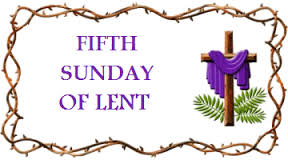
Gospel text : John 11:1-45
vs.1 There was a man named Lazarus who lived in the village of Bethany with the two sisters, Mary and Martha, and he was ill.
vs.2 It was the same Mary, the sister of the sick man Lazarus, who anointed the Lord with ointment and wiped his feet with her hair.
vs.3 The sisters sent this message to Jesus, “Lord, the man you love is ill.”
vs.4 On receiving the message, Jesus said, “This sickness will end not in death but in God’s glory, and through it the Son of God will be glorified.”
vs.5 Jesus loved Martha and her sister and Lazarus,
vs.6 yet when he heard that Lazarus was ill he stayed where he was for two more days
vs.7 before saying to the disciples, “Let us go to Judaea.”
vs.8 The disciples said, “Rabbi, it is not long since the Jews wanted to stone you; are you going back again?”
vs.9 Jesus replied: “Are there not twelve hours in the day? A man can walk in the daytime without stumbling because he has the light of this world to see by;
vs.10 but if he walks at night he stumbles, because there is no light to guide him.”
vs.11 He said that and then added, “Our friend Lazarus is resting, I am going to wake him.”
vs.12 The disciples said to him, “Lord, if he is able to rest he is sure to get better.”
vs.13 The phrase Jesus used referred to the death of Lazarus, but they thought that by “rest” he meant “sleep“, so
vs.14 Jesus put it plainly, “Lazarus is dead;
vs.15 and for your sake I am glad I was not there because now you will believe. But let us go to him.”
vs.16 Then Thomas – known as the Twin – said to the other disciples, “Let us go too, and die with him.”
vs.17 On arriving, Jesus found that Lazarus had been in the tomb for four days already.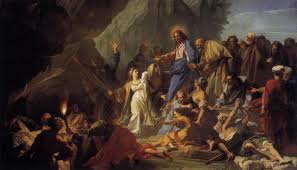
vs.18 Bethany is only about two miles from Jerusalem,
vs.19 and many Jews had come to Martha and Mary to sympathize with them over their brother.
vs.20 When Martha heard that Jesus had come she went to meet him. Mary remained sitting in the house.
vs.21 Martha said to Jesus, “If you had been here, my brother would not have died,
vs.22 but I know that, even now, whatever you ask of God, he will grant you.”
vs.23 “Your brother” said Jesus to her “will rise again.”
vs.24 Martha said, “I know he will rise again at the resurrection on the last day.”
vs.25 Jesus said: “I am the resurrection. If anyone believes in me, even though he dies he will live,
vs.26 and whoever lives and believes in me will never die. Do you believe this?”
vs.27 “Yes, Lord,” she said “I believe that you are the Christ, the Son of God, the one who was to come into this world.”
vs.28 When she had said this, she went and called her sister Mary, saying in a low voice, “The Master is here and wants to see you.”
vs.29 Hearing this, Mary got up quickly and went to him.
vs.30 Jesus had not yet come into the village; he was still at the place where Martha had met him.
vs.31 When the Jews who were in the house sympathizing with Mary saw her get up so quickly and go out, they followed her, thinking that she was going to the tomb to weep there.
vs.32 Mary went to Jesus, and as soon as she saw him she threw herself at his feet, saying, “Lord, if you had been here, my brother would not have died.”
vs.33 At the sight of her tears, and those of the Jews who followed her, Jesus said in great distress, with a sigh that came straight from the heart,
vs.34 “Where have you put him?” They said, “Lord, come and see.”
vs.35 Jesus wept;
vs.36 and the Jews said, “See how much he loved him!”
vs.37 But there were some who remarked, “He opened the eyes of the blind man, could he not have prevented this man’s death?”
vs.38 Still sighing, Jesus reached the tomb; it was a cave with a stone to close the opening.
vs.39 Jesus said: “Take the stone away.” Martha said to him, “Lord, by now he will smell; this is the fourth day.”
vs.40 Jesus replied, “Have I not told you that if you believe you will see the glory of God?”
vs.41 So they took away the stone. Then Jesus lifted up his eyes and said:
vs.42 “Father, I thank you for hearing my prayer. I knew indeed that you always hear me, but I speak for the sake of all these who stand round me, so that they may believe it was you who sent me.”
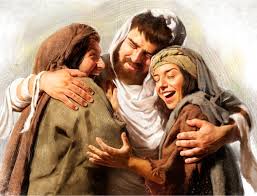 vs.43 When he had said this, he cried in a loud voice, “Lazarus, here! Come out!”
vs.43 When he had said this, he cried in a loud voice, “Lazarus, here! Come out!”
vs.44 The dead man came out, his feet and hands bound with bands of stuff and a cloth round his face. Jesus said to them, “Unbind him, let him go free.”
vs.45 Many of the Jews who had come to visit Mary and had seen what he did believed in him.
*********************************************
We have four sets of homily notes to choose from. Please scroll down the page for the desired one.
Michel DeVerteuil : A Holy Ghost Priest, Specialist in Lectio Divina
Thomas O’Loughlin: Professor of Historical Theology, University of Nottingham
John Littleton: Director of the Priory Institute Tallaght. Dublin 24
Donal Neary SJ: Editor of The Sacred Heart Messenger
*******************************************************
Michel de Verteuil
Lectio Divina with the Sunday Gospels – Year A
www.columba.ie
General notes
As on last Sunday, we have a long passage in which several stories are interwoven. Jesus brings Lazarus out of the tomb; this is experienced as a liberation from bondage – “Unbind him and let him go free.“ Identify with Lazarus from your experience. He symbolizes those who have been written off (by others but also by themselves) as dead – individuals, or as communities, or a country or a civilization?
Textual comments
Verses 3 and 36; 15; 39; 41 and 42 : Faced with the bondage of the tomb, Jesus is armed with love (verses 3 and 36), trust in the Father (vs. 15, 39, 41 and 42), and deep compassion (vs. 33, 35, 38). Enter into the dramatic confrontation in which these forces are victorious over death.
Verses 25 – 26; 29 and 40 : Jesus leads Martha (and to a lesser extent Mary) to a new insight into the power of faith over death by his teaching (vs. 25 and 26) and by commanding her to take the stone away (vs. 29 and 40). Recognize this journey from your own discovery of the power of faith over the forces of death and whatever keeps us in bondage. Where is Jesus teaching us this by word and example?
Verses 9 and 10 : Jesus returns to Judaea, the place of death, in perfect freedom, because of his own faith which is an inner light that keeps him from stumbling.
The disciples decide to accompany Jesus in his journey to death, which turns out to be a place of new life and freedom. When did you or your community take such a risk and experience a similar surprise?
Since we are approaching Holy Week, interpret the story of the crucifixion of Jesus in the light of this story: there too, faith and love prove victorious over the forces of death and darkness.
Scripture Reflection
Lord, we remember today the times when we were like Lazarus in the tomb, rejected, discouraged, in despair, feeling that life was not worth living, overwhelmed by guilt so that we wanted to hide ourselves away from the world.
rejected, discouraged, in despair, feeling that life was not worth living, overwhelmed by guilt so that we wanted to hide ourselves away from the world.
We thank you that you sent Jesus to us as we lay in the tomb
–a friend, a parent, uncle or aunt,
– some member of our church community
– an employer and this Jesus loved us, reached out to us in the tomb, and in a loud, confident voice, called us to come out.
Thank you, Lord.
“Christianity is not about opposing evil. It is a call to live in contrast to the prevailing mode of fragmentation and despair.” ….Derrick Wilson, founder of the ecumenical Corrymeela Centre in Northern Ireland
Lord, there are many who are Lazarus in our country,
seeming alive but really in the tomb:
– those who are letting themselves be killed by alcohol or drugs,
– those who are cynical, who have no energy or enthusiasm,
– those who are lost in our own national history
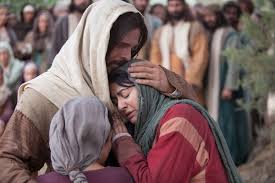 We ask you to send them Jesus
We ask you to send them Jesus
– someone who will be a friend to them as Jesus was to Lazarus,
– will not be afraid to remove the stone that is closing them in,
– will ignore us when we protest that they are already four days in the grave
and will smell,
– will call them to come out, and set them free.
“How much better to carry relief to the poor rather than sending it.” ….John Wesley
Lord, we thank you for Jesus’ great distress, for the tears he shed, for the sighs that came straight from the heart.
We come to you today with our own grief,
our anger in the face of death, hatred, cynicism and despair.
Teach us, like Jesus, to leave ourselves in your hands,
remembering that you always hear our prayers,
if we only believe we will see your glory,
and through our faith we can call Lazarus from the tomb,
unbind him and set him free.
“All the doctrinal work of the Church is focused in only one direction, serving human beings in their every condition, in their every ailment, and in every way. …. Pope Paul VI
 We pray for your Church, in our country and in the world,
We pray for your Church, in our country and in the world,
– that we may be Jesus in the world,
– walking without stumbling because we are walking in your light;
– not afraid to go to Judaea even when we know we could be put to death there;
– that we may let ourselves be led to where Lazarus is lying in a tomb,
– so that we can share in the grief of the world and in its sighs.
Fill your Church with the love of Jesus for Lazarus,
and with his trust in you, so that she may call him out of the tomb and set him free.
And Lord be merciful even when your Church sins and hurts it’s own people.
*******************************************
Thomas O’Loughlin
Liturgical Resources for the Year of Matthew
www.columba.ie
Introduction to the Celebration
Today we recall how Jesus was told of the death of his friend Lazarus and how he restored him to life. In this we have a ‘trailer’ of the whole message of Christian life: to believe in Jesus Christ is to be brought out of the tomb of death, freed from what binds us, and offered eternal life.
Let us now reflect on our own need to be freed from sin, our own need to have burdens lifted, and our own need to begin life afresh.
Homily notes
1. What does believing in the resurrection mean in our lives The temptation is to make an abstract statement about what one ‘believes‘ will happen post mortem, but Christian faith is much more than this: it requires that we live as people who have been raised to new life and for whom death and the tomb are not the end.
To believe in this sense is not to assent to a set of statements beyond what can be proven by some sort of empirical observation, but to adopt a lifestyle that embodies the assumption that God is calling each of us to new life. Christian believing is, therefore something that requires constant practice. This means that I cannot believe, in my life, and living and activity, that God is offering people new life, while being indifferent to human suffering, pain, poverty, or oppression.

2. Many people dwell at length on the difficulties of believing and wondering whether they can assert as true or false some statement such as ‘there is life after death‘ or ‘there is a continuation of personal identity after death‘ or whether or not there is a cycle of reincarnation‘. But these speculations are quite irrelevant to the gospel- and its challenge of taking the difficulties of the lifestyle of resurrection do not attract the same attention as the abstract ‘difficulties of believing’. The gospel writers all believed that there was a caring and involved God, and and individual identity that survived death, and that there was an ‘afterlife’ – none of these beliefs are an issue in the gospels they are simply assumed. What they proclaim as new, and as revealed in Jesus, is that God offers a covenant of forgiveness that cannot be destroyed, and the invitation to follow the way of holiness is to live life after the pattern of that forgiving and constant divine love.
As we are loved, so we love;
as we are forgiven, so we forgive;
as we receive mercy, so we must be merciful, and
as our lives are transformed, so we must help to transform the lives of others.
What we wish for from God on the heavenly plane, must be that which we transmit to others on our own human plane. So to believe in resurrection, and in the resurrection of Jesus, is to live such a life, of hope:
if I look forward to mercy and fullness of life from God, how can I not show mercy to someone in need;
if I look to the transformed life of heaven, how can I not want to transform the lives of those suffering on earth.
Here lies a difficulty: is it easier to engage in disputes over abstract beliefs; or to engage in alms-giving and be really committed to a just world – perhaps one where one has to take a fall in one’s own standard of living so that others can have a better life? Believing in resurrection is not ‘yippee, I’m saved by Jesus’, but something very costly: I believe I am given new life; I must act on that as the fact in my life and convey new life to others.
3. On the other hand, we have to note how we often live within a pattern of attitudes that are equivalent to denying resurrection. The gospel today shows up several of the main forms of non-belief.
Firstly, attitudes of despair in the face of human suffering deny resurrection. Here are some of the standard expressions of despair: ‘Why bother when it will make no difference,’ or ‘There is nothing to be done,’ or ‘It is too late.’ We must act with hope and one only needs hope when one is in the presence of adversity.
Secondly, attitudes of it ‘all being too much bother’ when faced with wickedness or falsehood or discrimination. There are always difficulties – ‘there will now be a smell’ – but until we confront them as a community which is strengthened by God’s grace, those difficulties will only grow. Not that there is any guarantee that in confronting them we will succeed or that we will not encounter suffering – our symbol is a cross – but that in confronting the difficulties we look forward to the final victory of the Christ.
Thirdly, attitudes of fatalism: the assumption that there is really no hope of things changing, and that there is no possibility of conversion. Lazarus is already in the tomb, dead and bound. Such an attitude of fatalism denies the forgiving nature of God, and denies that there can be goodness in his universe.
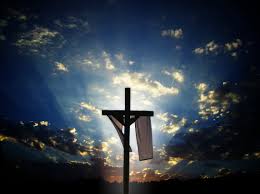 4.It is in confronting each day the suffering, darkness, and wickedness that can engulf us that we show that we believe that Jesus is the resurrection and the life, the one who has shattered all that oppresses us.
4.It is in confronting each day the suffering, darkness, and wickedness that can engulf us that we show that we believe that Jesus is the resurrection and the life, the one who has shattered all that oppresses us.
‘Belief in resurrection may seem one of the most abstract aspects of our religion, yet nothing makes such concrete and material demands on us.‘
**********************************************************
John Litteton
Journeying through the Year of Matthew
www.Columba.ie
Gospel Reflection
How much is our faith like Martha’s faith? During Jesus’ visit to Martha and Mary after the death of Lazarus, Martha professed true faith in him. When Jesus asked her if she believed that he was the Resurrection and the Life, she acknowledged him as ‘the Christ, the Son of God, the one who was to come into this world’ (Jn 11:27). Martha was one of the few people in the New Testament who expressed such a faith in Jesus before his own death and resurrection. Another person who expressed a similar faith was Peter (see Mt 16:16). Thus Martha’s faith anticipated a truly Easter faith.
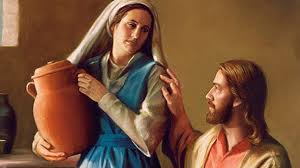 Martha believed that physical death was not the end. Instead, physical death gave way to eternal life because, for her, Jesus Christ was (and is) the Lord of life. Martha looked forward to the resurrection of the body on the last day. Meanwhile she maintained a sure and certain hope that is characteristic of the basic Christian hope which is at the heart of our Christian faith.
Martha believed that physical death was not the end. Instead, physical death gave way to eternal life because, for her, Jesus Christ was (and is) the Lord of life. Martha looked forward to the resurrection of the body on the last day. Meanwhile she maintained a sure and certain hope that is characteristic of the basic Christian hope which is at the heart of our Christian faith.
At Easter, we celebrate Jesus’ resurrection from the dead. Because he is risen, all of us will likewise be raised from the dead. We are all invited to share in his death and resurrection and, provided we are committed to the newness of the risen life that he offers us, we gain an everlasting place in heaven. This means that if we turn away from the sins that separate us from God — for example, irreligion, theft, adultery, disregard for parents, and drunkenness — we will gain heaven for eternity. This is the real meaning of Easter, and the resurrection of Jesus from the dead is at the centre of our Christian faith.
Therefore, as Paul teaches (see 1 Cor 15:14), if Jesus is not raised from the dead, then our faith is in vain and we are foolish people. The resurrection of Jesus from the dead is the proof that everything he said and did in his public ministry is true, bearing in mind that what he is portrayed as saying and doing in the gospel has been painted with ‘resurrection spectacles’. Sharing in his risen life demands that we remain faithful to his teaching and committed to his Church.
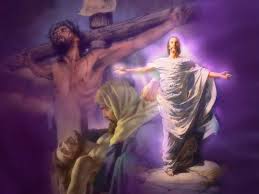 The all-important question for us at Eastertide is: Do we sincerely believe, like Martha, that Jesus Christ is the Resurrection and the Life? In other words, do we accept that he is raised from the dead and that he is the Lord of life? How can we have the sure and certain hope that was characteristic of her faith? Martha provides an inspiring example of Easter faith. Despite her obvious grief at the death of Lazarus, she put her faith completely in Christ. We are challenged to do the same.
The all-important question for us at Eastertide is: Do we sincerely believe, like Martha, that Jesus Christ is the Resurrection and the Life? In other words, do we accept that he is raised from the dead and that he is the Lord of life? How can we have the sure and certain hope that was characteristic of her faith? Martha provides an inspiring example of Easter faith. Despite her obvious grief at the death of Lazarus, she put her faith completely in Christ. We are challenged to do the same.
How much is our faith like Martha’s faith? Let our prayer today be: Lord, our God, strengthen our faith in Jesus Christ, the Resurrection and the Life. May we learn from Martha’s example so that the message of Easter may change our lives and lead us to eternal life.
For meditation
I am the resurrection.
If anyone believes in me, even though he dies he will live,
and whoever lives and believes in me will never die. (Jn 11:25-26).
**********************************************************
Donal Neary SJ:
Gospel Reflections for Sundays of Year A: Matthew
www.messenger.ie/bookshop/
A Human Heart
When people read this they say they see that Jesus is a real human being, son of God, God of heaven, man of the earth, weeping over a friend.
His was a human heart. He liked friends and he found a home and a safe place with them, over the hill and away from the mob. We might picture him there – the talk, the chat, the prayers, the love; meals with other friends who dropped in, times of prayer and silence.
The one who can share a laugh, eat a scone, have a drink or a cuppa. The one who’d give a wink at the sign of peace! Not always so serious, even about religion. There’s no such thing as a sad saint!
He is a good friend. Friendship gives new spirit.
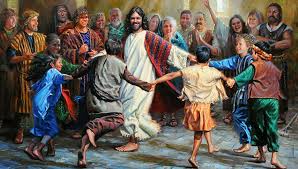
When life is ending we will give thanks for friends, and regret the way we have drifted or hurt each other. Real friendship is when another’s thoughts and life become at least as or more important than our own.
So the resurrection and the life is not just for after death. It is for now. We raise each other up in friendship and in love. In that is the grace of the Lord, himself a friend, for when we love, God lives in us.
Picture your friends and those you love and give thanks to God for each of them.
Lord, help me to keep love and friendship alive in my life.
*************************************************